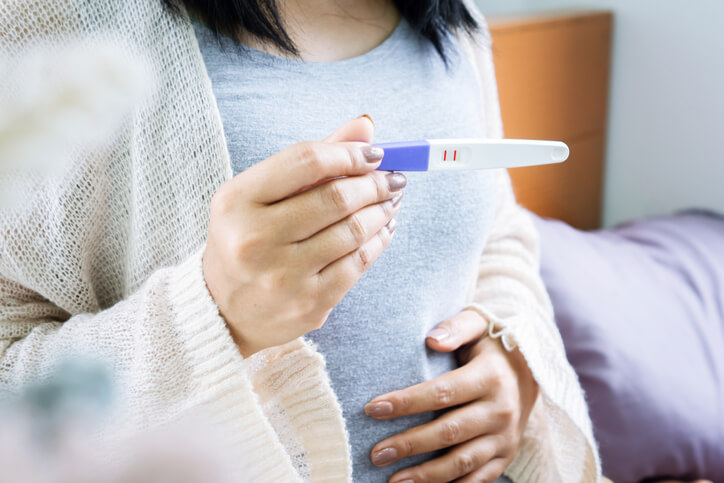At-home pregnancy tests are a quick, convenient, and inexpensive way to tell if you have a baby on the way.
But as convenient as they may be, reading the test results might not be the most straightforward task to do.
After all, each pregnancy test has a different way of displaying the results, and that test line may not always be clear.
In this article from PregnancyResource.org, we go over how pregnancy tests work, how to tell if a pregnancy test is positive, and how to take a pregnancy test to get the most accurate results.
How Does a Pregnancy Test Work?
There are two types of pregnancy tests: urine tests and blood tests.
If you’re going to the doctor to get tested for pregnancy, you’ll probably do a blood test. This is the most accurate pregnancy test, which can detect pregnancy very shortly after conception.
That said, it does require a doctor’s appointment (in addition to drawing blood), which may not be the most convenient option for people who want to know sooner than later.
At-home pregnancy tests are a much quicker way to confirm a pregnancy. They use your urine to tell if you’re pregnant, and cost relatively little ($10 dollars on average).
Plus, they can be purchased over-the-counter — which means you don’t need a doctor’s prescription to get them.
To determine if you’re pregnant, an at-home pregnancy test looks at how much human chorionic gonadotropin (hCG) there is in your body.
Called the pregnancy hormone, hCG levels increase in the female body immediately after getting pregnant.
Levels of hCG build up right after the fertilized egg implants itself in the uterus, which is about eight to 10 days after conception.
However, it takes a little bit of time for the hormone hCG to build up in your urine. The pregnancy hormone may be present in your urine sample around two weeks after ovulation.
For this reason, it’s common for early at-home tests to come back negative. Experts generally recommend waiting until your first missed period to take a pregnancy test for the most accurate results.
What Does a Positive Pregnancy Test Look Like?
In an at-home pregnancy test kit, test strips react with the hCG in your urine, and may turn a different color.
This usually shows up either as a plus sign or double vertical lines. Digital pregnancy tests may even show the word “pregnant” on a display.
Most pregnancy tests use two vertical lines in a results window to tell you if you’re pregnant.
One line will be the control line and will be displayed on the pregnancy test whether you’re pregnant or not. It is often light pink in color.
After taking the test and waiting a set amount of time, a second positive line will pop up only if high enough hCG levels are detected in your urine.
This line will typically be bright red — much darker and more prominent than the control line. Even if the second line is a faint line, it’s considered a positive test result and is a sign of pregnancy.
Although this display is the most common, it can vary between tests, so make sure to read the instructions on your home pregnancy kit before taking it to ensure you understand what the results may look like.
How Do You Take a Pregnancy Test?
When you take an at-home pregnancy test, you’ll have to place several drops of urine on a special piece of paper located on the pregnancy test stick.
The strip reacts with the hCG hormone in your urine to produce a result.
To ensure your pregnancy test results are as accurate as possible, follow these tips:
- Every at-home pregnancy test is different, so make sure to read the directions and follow all instructions that come with your specific test kit.
- Take your test after your first missed period — this will give hCG more time to build up in your urine, reducing the chances of a false negative result.
- Take the test first thing in the morning as this is when the hCG in your urine will be the most concentrated.
- If you can’t take the test in the morning, make sure to wait several hours after using this bathroom to give hCG more time to build up in your urine.
- Avoid drinking too much water (or other fluids) right before your test, which can dilute hCG levels.
Can a Pregnancy Test Be Wrong?
Although pregnancy tests are 99% accurate when done properly, false negatives and false positives are possible.
- False negative: The test says you’re not pregnant when you actually are.
- False positive: The test says you are pregnant when you actually are not.
You can get a false negative pregnancy test result for the following reasons:
- You take the test too early: If taken too early in the pregnancy, an at-home pregnancy test may not detect adequate hCG levels in your urine.
- You check the test results too soon: It can take some tests up to five minutes to display the results. Checking too early before tossing the test can give you a false negative.
- You drank too many fluids: If your urine is too diluted, then a pregnancy test may not pick up on hCG because it’s been too diluted.
It is very rare to have a false positive test. However, it can happen if you have a pregnancy loss shortly before taking the test.
It’s also possible for some medications, such as fertility drugs, to raise hCG levels, leading to a false positive result.
If urine evaporates from the test strip, it could also show as an evaporation line and not a positive result.
Lastly, some medical conditions that affect the ovaries — such as polycystic ovarian syndrome (PCOS) — can also contribute to an inaccurate pregnancy test reading.
In Conclusion
Most at-home pregnancy tests use a vertical line to tell you if you’re pregnant. If a second vertical line shows up on the screen, it is very likely that you’re pregnant.
While you don’t have to rush to your healthcare provider, make sure to go in for a check-up within a month of getting your results.
This will help lower the risk of complications (which is especially important given the COVID-19 pandemic) while making sure that you stay as healthy as possible early on in your pregnancy.
References and Sources:
Human Chorionic Gonadotropin: Hormone, Purpose & Levels | Cleveland Clinic
7 Causes for a False-Positive Pregnancy Test | Healthline
Taking a Pregnancy Test When You Have PCOS: What to Know | Healthline

Bridget Reed is a Tampa-based content development manager, writer, and editor at GR0; specializing in content related to varying fields including medicine, health, and small businesses. Bridget went to St. Petersburg College and majored in Management and Organizational Leadership.
Recent Publications: Body Acne 101: Prevention and Treatment, Stress Acne: Causes, Prevention, and Treatment, What are the Side Effects of Midol?

